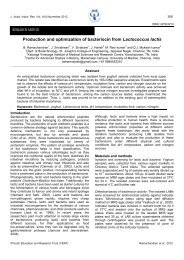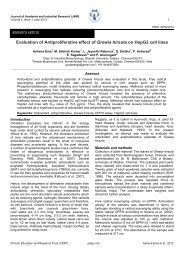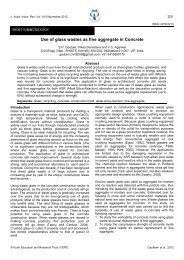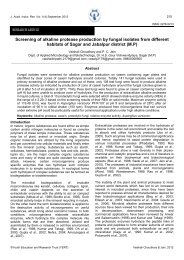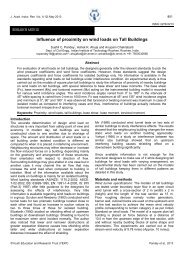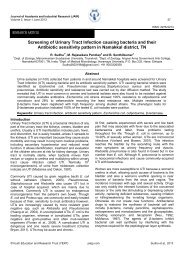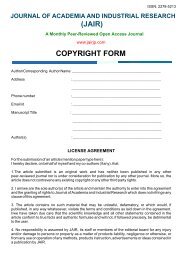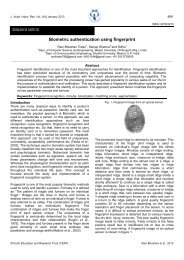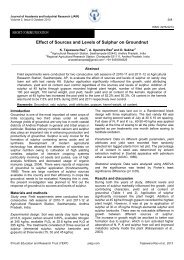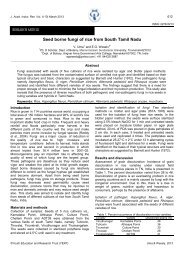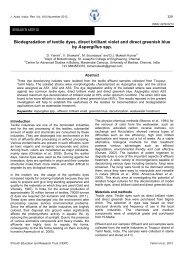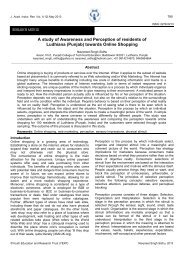Isolation of bacteriocin nisin producing Lactococcus lactis from dairy ...
Isolation of bacteriocin nisin producing Lactococcus lactis from dairy ...
Isolation of bacteriocin nisin producing Lactococcus lactis from dairy ...
You also want an ePaper? Increase the reach of your titles
YUMPU automatically turns print PDFs into web optimized ePapers that Google loves.
J. Acad. Indus. Res. Vol. 1(10) March 2013 628The isolated colonies were further subcultured andtransferred to MRS slants incubated at 37C for 48 h andpreserved at 4C for further work.Morphological and biochemical tests: The isolates weregrouped as lactic acid bacteria after examining theirgram reaction, cell and colony morphology, catalasereaction and gas production <strong>from</strong> glucose fermentation.The test isolate LAB, <strong>Lactococcus</strong> <strong>lactis</strong> was used forfurther optimization process.Effect <strong>of</strong> heat treatment on bateriocin production:Aliquots (5 mL) <strong>of</strong> sterile CBS were heated at 70, 80, 90and 100C for 20 min in a thermostatically controlledwater bath and at 121C for 20 min in an autoclave. Thetreated samples were tested for antibacterial activityagainst the indicator bacterial strains. Untreated cultureconcentrated served as a positive control.Plate 1. Growth <strong>of</strong> L. <strong>lactis</strong> on MRS media.Optimum temperature for growth <strong>of</strong> L. <strong>lactis</strong>: <strong>Lactococcus</strong><strong>lactis</strong> culture was inoculated in 100 mL MRS broth at100 rpm in a shaking incubator at different temperaturesranging <strong>from</strong> 30, 35, 37 and 40C. Samples were takenevery hour for the first 12 h and then at 14, 16, 20 and24 h for enumeration <strong>of</strong> LAB in MRS agar and incubatedat 37C for 24-36 h.Controlled pH for growth <strong>of</strong> L. <strong>lactis</strong>: <strong>Lactococcus</strong> <strong>lactis</strong>strain was grown in MRS broth supplemented with2% yeast extract, 0.2% glucose and 0.2% meat extractincubated at 37C for 24 h. The pH <strong>of</strong> fermentation wasmaintained constantly at 6, 6.5 and 7 by addition <strong>of</strong>1 M NaOH and uncontrolled-pH fermentation was alsoinvestigated. Samples were taken every hour for the first12 h and then were taken at 14, 16, 20 and 24 h.Preparation <strong>of</strong> crude <strong>bacteriocin</strong> supernatant (CBS):Overnight cultures <strong>of</strong> L. <strong>lactis</strong> were inoculated to 25 mLMRS broth incubated at optimum temperature for12-16 h to reach stationary phase. The cultures wereprepared for CBS by centrifugation at 12,000 x g for20 min at 4C for determining <strong>bacteriocin</strong> activity by agarwell diffusion assay. The inhibition activity was reportedas diameter (mm) <strong>of</strong> a clear inhibition zone.Bacteriocin assay method by agar well diffusion:Bacteriocin screening was performed by well diffusionmethod. The target strains used in this study wereE. coli, S. aureus and Bacillus sp. and they weresubcultured in tryptone soy broth (TSB) for 24 h foractivation prior to antimicrobial activity. The antimicrobialactivities <strong>of</strong> the isolates were quantified by agar welldiffusion method. An isolated colony was selected <strong>from</strong>MRS agar plate culture and the growth is transferred intoa tube containing sterile MRS broth (5 mL), incubated at35C for 24 h. To get the culture filtrate, a 24 h culturewas centrifuged at 10,000 rpm for 20 min and heattreatment process was done. An actively growing testorganism in TSB <strong>of</strong> 24 h culture were dipped with asterile cotton swab and overlaid on MHA plates. Wells <strong>of</strong>approximately 6 mm were bored in the agar medium.The well was filled with culture filtrates. After 12-24 h <strong>of</strong>incubation, each plate was examined. The diameter <strong>of</strong>the zones <strong>of</strong> complete inhibition was examined, includingthe diameter <strong>of</strong> the well.Table 1. Physiological and biochemical characteristics <strong>of</strong> L. <strong>lactis</strong>.Colony morphologyRaised and circularCell morphologyCocciCell arrangementPairs and short chainsGram reactionPositiveSpore formationNegativeCatalase activityNegativeGlucose fermentationPositiveSalt tolerance testNaCl at 2%PositiveNaCl at 4%PositiveNaCl at 6.5%PositiveResultsA total <strong>of</strong> 120 colonies <strong>from</strong> the fermented food sampleswere examined, <strong>of</strong> which 12 colonies were recorded aspositive, <strong>producing</strong> inhibition zones on agar media.Of these colonies, only one strain No. 12 stably secretedinhibitory substances into culture broth. This <strong>bacteriocin</strong><strong>producing</strong> strain was gram positive, catalase-negative,coccus, non-motile and produced no gas <strong>from</strong> glucosewas potentially identified as <strong>Lactococcus</strong> <strong>lactis</strong> (Plate 1and Table 1). Optimum temperature <strong>of</strong> L. <strong>lactis</strong> growth inMRS broth was found to be 37C in 8 h (Table 2).When the pH <strong>of</strong> fermentation <strong>of</strong> L. <strong>lactis</strong> was constantlyheld at 6.0, 6.5, 7.0 and uncontrolled, at 37 o C then theviable cell counts <strong>of</strong> L. <strong>lactis</strong> and absorbance at 600 nmwere determined. Viable cell counts <strong>of</strong> L. <strong>lactis</strong> andabsorbance <strong>of</strong> fermented media during 24 h wasobserved. The maximum <strong>of</strong> absorbance (in term <strong>of</strong>absorbance reading at 600 nm) and bacterial growthwere observed at 8 h at pH <strong>of</strong> 6.5 (Table 3). Antimicrobialactivity <strong>of</strong> standard antibiotics was tested against E. coli,S. aureus and Bacillus sp. and degree <strong>of</strong> inhibitiontowards test organisms were given in Table 4.©Youth Education and Research Trust (YERT) Nagalakshmi et al., 2013



